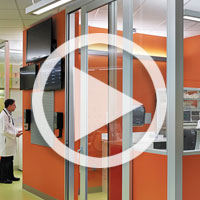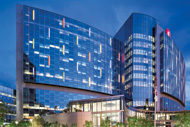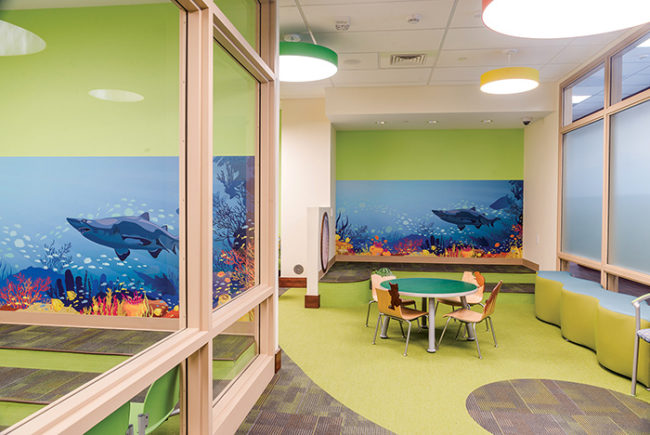
View "Forward-focused furnishings" Gallery
In a survey of 250 nurses conducted in March by independent research firm GMI, Bellevue, Wash., more than 60 percent of respondents indicated that the placement of technology and the manner in which it is integrated into their workflow are among the biggest challenges nurses face today. Ergotron Inc. (www.ergotron.com), St. Paul, Minn., a manufacturer of digital display mounting and mobility products, commissioned the 2014 nursing study to examine the effects of digital health care on nurses and their patients.
Electronic devices are omnipresent and important tools in health facilities, but as the study revealed, technology is not always integrated well into the health care environment. Manufacturers are responding to this need with products intended to make technology easier and more comfortable to use in health care settings.
Information sharing
Ergotron offers a variety of desk and wall mounts, workstations, computer carts, charging stations and accessories designed for ergonomic and convenient computer use. The products are highly adjustable, allowing monitors to be positioned so that caregivers can interact with patients face-to-face while using the equipment, rather than twisting awkwardly to turn between the patient and the keyboard.
The company’s StyleView carts provide 20 inches of vertical adjustability, meeting the ergonomic requirements of 95 percent of all users, says Steve Reinecke, assistant vice president, Ergotron Healthcare. The company’s streamlined, wall-mounted charging stations and computer arms are designed to make efficient use of health care spaces.
The APTUS cart and APTUS laptop arm by Modular Services Co. (www.modularservices.com), Oklahoma City, Okla., also are compact and ergonomically designed. Both products allow for simple, one-handed movement and height adjustment. The cart includes a lithium battery compartment for additional power and run time for point-of-care technical applications. The laptop arm features a quick-connect locking bar to hold laptops securely, and the tray flips up to store out of the way when not in use.
The Pocket cart by Steelcase Health (www.steelcasehealth.com), Grand Rapids, Mich., can support a number of technologies, including laptops, tablets, monitors and CPUs, as well as pen and paper. “Technology is really starting to find its way into every aspect of the health care environment. It’s not just at the nursing station or in the exam room,” says Alan Rheault, director of product design, Steelcase Health. Pocket’s small footprint, maneuverability and adaptable design make it easy for caregivers to access or enter data or discuss health information with patients in a number of settings.
Care teams can share data on the screens of their individual mobile devices or a central monitor by plugging into the Media:scape media sharing platform by Steelcase Inc. (www.steelcase.com), Grand Rapids. Remote participants can join in using a third-party videoconferencing system. Media:scape is available in lounge, seated and standing height configurations.
The Backbone media platform by KI (www.ki.com), Green Bay, Wis., provides a flexible, functional system for collaborative care that works with providers’ technology, says Debbie Breunig, the company’s vice president, health care market. The product can be purchased as a mobile or stationary unit, with a single table or multiple tables that can be arranged a number of ways. The Backbone unit will support a base-mounted flat-screen monitor, or the system can be used with a wall-mounted monitor.
Flexible systems
KI’s Genius movable wall systems can deliver power and data, allowing facilities to integrate media elements like monitors, television screens and gaming systems into walls. With the Genius wall system, these items “are embedded, yet flexible,” Breunig says.
As a facility’s programming and space needs change or technology advances, health systems can modify the wall system without having to cut into drywall. This eliminates much of the noise, dust, commotion and loss of revenue that can be associated with a renovation project. Movable walls also can provide pathways for larger medical technologies, giving providers a route by which equipment like magnetic resonance imaging systems can be moved through the building when it is time to upgrade this technology. “That’s the name of the game, keeping space flexible,” Breunig says.
Technology advances so rapidly “you don’t know what it will look like next year,” notes Kristin J. Moore, LEED AP, director of health care, DIRTT Environmental Solutions (www.dirtt.net), Calgary, Alberta, Canada. The components of DIRTT wall, door, millwork, power, network and floor systems can be reconfigured almost like LEGO pieces to respond to changing conditions.
The DIRTT wall system features an internal cavity in which screens or electronic components can be embedded along with network cabling, hospital-grade electrical service or medical gas lines. Hospital facilities staff can remove the system’s external wall tiles to change out elements as necessary. “The platform is flexible, so you don’t have to try to predict the future,” says Moore. “Changes can happen without facilities’ having to replace or repair the walls.”
DIRTT health care clients have used this system to incorporate flat-screen TV monitors into the walls of patient rooms, eliminating dust-catching horizontal TV surfaces and protecting the screens to the extent that they can be wiped down with bleach, if required. DIRTT wall components also have been used to embed screens displaying patient vital signs in the footwall of rooms in an intensive care unit, where this information can be seen easily by everyone on the care team.
Patients and visitors
Caregivers aren’t the only ones using technology in health facilities. Patients and visitors are bringing their own electronic devices into the health care space, as well. Furnishings manufacturers are working to accommodate their needs, too.
The Palisade Collection by Nemschoff Inc. (www.nemschoff.com), Sheboygan, Wis., provides power outlets, USB ports, adjustable lighting and convenient work surfaces so family members who may spend hours or days at a time in a patient room can continue to run their lives outside the room. “Technology enables them to stay in touch with others or pass the time,” says Nicole Allis, portfolio lead, Nemschoff. “They can plug in and stay connected to work and family, and they don’t have to leave the bedside.”
KI’s MyWay guest seating collection includes a tablet armchair with a surface made to support electronic devices, books or notepads. Users can recharge their devices via USB ports and standard power outlets that are built in to the chair in an easily accessible location.
“Everybody has some sort of handheld device. We’re tethered to technology,” says Breunig. More and more tools are being developed to monitor, store and retrieve health information on smartphones, bringing the “handheld hospital” closer to reality, she notes. As technological advances change how health care is delivered, facility interiors are keeping pace to create environments in which caregivers and patients can make the most of this progress.





